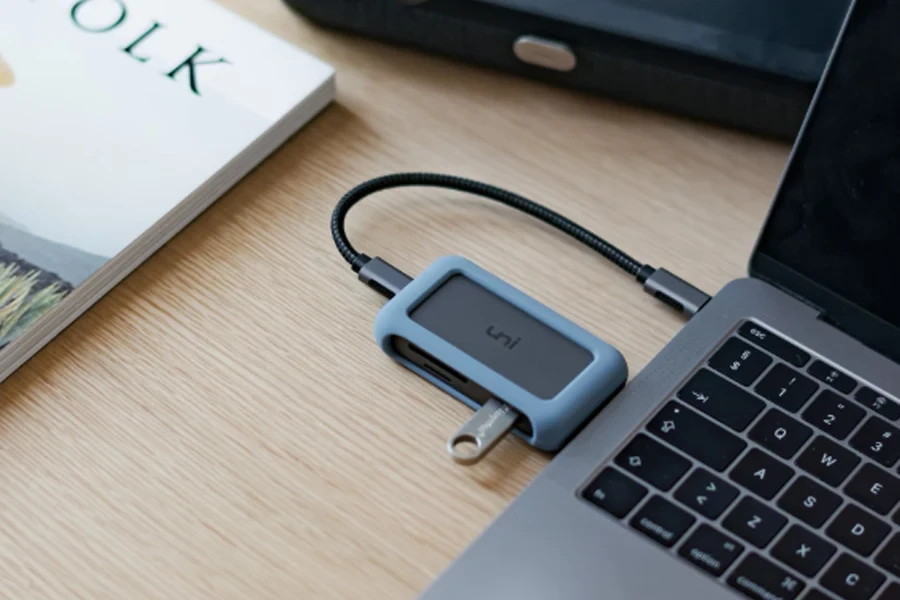Table of Contents
● Introduction
● Market overview
● Innovations in flash drive performance
● Enhanced security features
● Choosing the right USB flash drive
● Conclusion
Introduction
In an era dominated by cloud storage solutions, USB flash drives continue to hold a significant role in the rapid and reliable transfer of data. Their evolution reflects a constant push toward faster data handling, greater storage capacities, and enhanced portability, catering to both business professionals and tech enthusiasts. As the technology advances, these devices are becoming more integral in scenarios where internet access is limited or where large volumes of data need to be securely transferred or backed up. The latest innovations in USB flash drive technology not only meet the increasing demands for storage efficiency but also adapt to the modern user’s needs for security and speed.

Market overview
The USB flash drive market is on an upward trajectory, projected to grow from a valuation of $90 million in 2020 to an impressive $146.2 million by 2027, marking a robust compound annual growth rate (CAGR) of 7.1%, as noted in a recent market analysis on LinkedIn. This significant growth is largely fueled by the escalating need for secure data storage solutions amidst increasing digitalization across various sectors. As data generation continues to surge, driven by expanding digital content such as high-definition videos and comprehensive data files, the demand for USB flash drives that offer both high-speed data transfer and robust security features is also rising. The integration of advanced encryption technologies into USB flash drives is becoming increasingly popular, enhancing their appeal to security-conscious users ranging from government agencies to private enterprises looking to safeguard sensitive information against escalating cyber threats.
On the geographical front, significant growth is expected in regions such as North America and Asia-Pacific, which together are projected to account for over 55% of the market share by 2027, according to industry reports on LinkedIn. Specifically, the market in China is expected to dominate with a 30% share, driven by its substantial investments in digital infrastructure and a robust manufacturing sector that increasingly relies on high-speed, secure data transfer solutions. The United States is anticipated to hold a substantial 25% market share, reflecting its leading role in technological advancements and high adoption rates of new security technologies in data management. These regional market dynamics highlight the critical role of USB flash drives as essential tools for data management and security in an increasingly digital world, underscoring the importance of these devices in global markets.
Innovations in flash drive performance
Accelerating USB flash drive speeds
The evolution of USB flash drives has primarily centered around enhancing data transfer speeds to meet the demands of modern technology users. Current models boast speeds that can exceed 500 MB/s, a significant improvement from the USB 2.0 era, which often capped around 60 MB/s. This speed enhancement is crucial for professionals like video editors and data analysts, who routinely transfer large datasets or multimedia files. Fast transfer speeds reduce waiting times significantly, thereby streamlining workflows and boosting productivity across various tech-intensive industries.

Modern data
As digital content continues to grow in size and complexity, the storage capacity of USB flash drives has expanded dramatically. Modern drives now offer capacities comparable to larger, more cumbersome external hard drives, with some models offering up to 2 terabytes of storage. This increase is a game-changer for users who need portable and reliable storage for extensive collections of large files, such as high-resolution images, video libraries, and extensive software applications. The ability to carry vast amounts of data in a compact form factor is a significant advantage in today’s digital landscape.
Enhancing workflow efficiency
For professionals across various sectors, the advancements in USB flash drive technology translate directly into enhanced workflow efficiency. In industries where time is critical—such as media production, engineering, and software development—the ability to quickly transfer large files between devices without dependency on network speeds is invaluable. Moreover, the portability of USB drives ensures that professionals can easily carry their work with them, facilitating seamless transitions between work environments and promoting flexibility in how and where work can be accomplished.
Convenience and security in data management
For individual users, the modern USB flash drive offers much more than just storage; it provides a blend of convenience, capacity, and security. People use these devices to back up personal data, carry entertainment libraries, and ensure that important documents are always within reach. Moreover, advancements in USB drive security, such as fingerprint authentication and hardware encryption, have made these devices more secure, giving users peace of mind that their personal data is protected against unauthorized access.
Trends and predictions
Looking forward, the role of USB flash drives is expected to evolve further as they become even more integrated into both professional and personal computing environments. With ongoing improvements in USB technology, future generations of flash drives are likely to offer even faster speeds and larger capacities. Additionally, as the Internet of Things (IoT) and smart devices continue to proliferate, the demand for portable, secure, and robust storage solutions like USB flash drives is expected to grow. This trend will likely encourage further innovations in the design and functionality of USB drives, solidifying their place as essential tools in the digital age.
Enhanced security features
Encryption and access controls
The latest USB flash drives come equipped with advanced security features designed to protect sensitive data from unauthorized access. Encryption technology has become a standard in the industry, with many drives now offering military-grade encryption such as 256-bit AES, which ensures that data remains secure even if the drive is lost or stolen. Additionally, access controls have been significantly enhanced, with biometric options such as fingerprint scanners becoming increasingly common. These security measures provide users with the confidence that their private information, whether personal or professional, is protected against potential cyber threats.

Hardware encryption in data protection
Hardware encryption is particularly noteworthy for its ability to secure data at the hardware level, offering a more robust security solution than software-based encryption, which can be vulnerable to malware. Hardware-encrypted USB drives automatically encrypt all data that is stored on them and require a decryption key that is typically stored separately from the device’s main storage area. This type of encryption is seamless to the user and occurs in real-time, adding no perceptible delay to the operation of the drive but significantly enhancing security.
Biometric security
The integration of biometric security features into USB flash drives marks a significant advancement in personal data protection. According to product overviews, drives with fingerprint authentication not only offer an additional layer of security but also streamline the process of accessing protected data. This technology ensures that only authorized users can access the drive’s contents, making it an excellent choice for professionals handling sensitive or proprietary information.
Choosing the right security features for sensitive data
When selecting a USB flash drive for sensitive data, the importance of robust security features cannot be overstated. For businesses and individuals alike, choosing a drive with adequate encryption and access controls is crucial. This decision should be guided by the specific security requirements of the data being stored; for example, legal professionals might require drives with tamper-proof features and strict data encryption to comply with privacy laws.
Future trends in USB flash drive security
Looking ahead, the trend towards ever-more secure USB flash drives is expected to continue. Innovations such as quantum encryption and more advanced biometric identifiers are likely on the horizon. As digital security threats become more sophisticated, the technology embedded in USB flash drives will also evolve, offering users more secure and convenient ways to store and transport their data in an increasingly interconnected world.
Choosing the right USB flash drive
Key considerations for selecting USB flash drives
When selecting a USB flash drive, several critical factors must be considered to ensure it meets both performance and security needs, as well as compatibility with intended devices. Performance is typically gauged by the drive’s data transfer speeds, which can significantly impact efficiency in professional settings. As technology advances, USB drives now offer speeds that can dramatically reduce the time required for data transfers, making quick access to large files a reality.
Ensuring security and compatibility
Security is another paramount consideration, especially for users handling sensitive or proprietary information. Modern USB flash drives come equipped with robust encryption protocols like 256-bit AES, often bolstered by hardware encryption, which provides an additional layer of security by encrypting data at the physical drive level. Compatibility extends beyond mere connectivity options, like USB Type-A or USB-C, and includes ensuring the drive’s file system is compatible with the operating systems of devices it will connect to, such as Windows, macOS, or Linux.
Tailoring flash drives to user requirements
To match flash drives with user needs and device requirements effectively, it’s important to first assess the primary use case of the drive. For instance, creative professionals such as videographers or photographers may prioritize drives with high transfer speeds and large capacities to efficiently manage large video files and images. In contrast, a business professional might focus more on security features and durability to protect sensitive data while traveling.
Integrating with device ecosystems
Moreover, considering the ecosystem of devices one frequently uses is crucial. For those embedded in the Apple ecosystem, selecting a drive with USB-C connectivity and support for macOS’s file structure may offer convenience and functionality. Conversely, for users predominantly operating within a Windows environment, choosing a drive that supports NTFS file format can be more beneficial to leverage the full capabilities of the flash drive.
Forward-looking USB flash drive selection
Anticipating future needs is also essential when choosing a USB flash drive. As file sizes and software complexity continue to grow, opting for a drive with a larger capacity than currently necessary can be a prudent decision, providing room for growth. Similarly, considering emerging trends and technology advancements in USB technology will help ensure that the selected flash drive remains useful and efficient for years to come.
Conclusion
USB flash drives continue to thrive in the digital era, proving indispensable in environments where speed, security, and reliability are paramount. Despite the rise of cloud solutions, these compact devices are advancing, with significant enhancements in data transfer speeds, storage capacities, and robust security features like hardware encryption and biometric protection. For business professionals, the evolution of USB flash drives ensures they remain essential for efficient and secure data management, particularly in sectors that demand the rapid mobilization of large data volumes under stringent security measures. As the market grows and technology progresses, these devices are set to remain a crucial tool for businesses navigating the complexities of modern data transfer and security.



